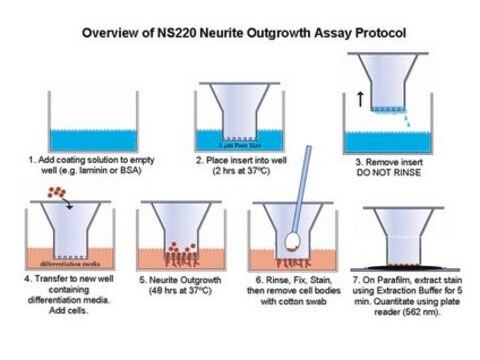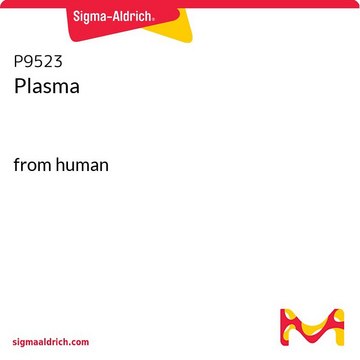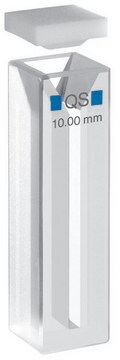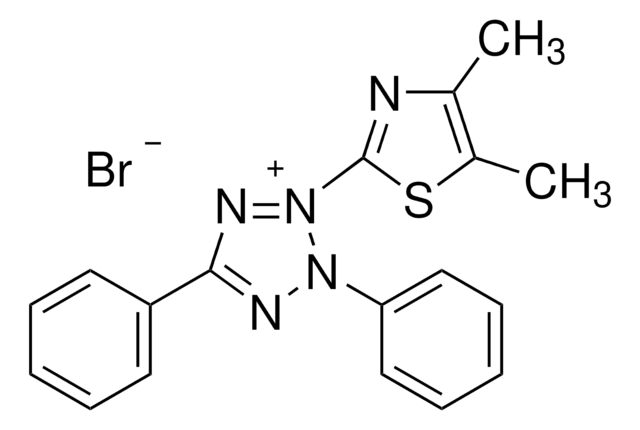Allgemeine Beschreibung
Application CHEMICON′s NS225 Neurite Outgrowth Assay Kit (1 μm) utilizes microporous tissue culture insert technology from Millipore and is based on the use of Millicell cell culture inserts (chambers) containing a permeable membrane with 1 μm pores at the base. The inserts are designed to fit into a receiver vessel, which when in use contains differentiation media in contact with the bottom of the insert membrane. The permeable membranes allow for discrimination between neurites and cell bodies, as projecting neurites will pass easily through the pores but cell bodies will not. Therefore, by inducing neurites to traverse these membrane pores, a purified population of neurites is located on the underside of the membrane, distal to the surface on which neural cell bodies are deposited. This kit has has been specifically designed for and validated with PC12 cells. The diameter of PC12 cell bodies is relatively small compared to that of many other cell types commonly used in neurite outgrowth assays [5, 6, 7]. As a result, many PC12 cell bodies may pass though pores larger than 1 μm, significantly obscuring neurite outgrowth assay results. Using a 1 μm pore size greatly reduces background and improves the signal-to-noise ratio in studies using PC12 cells. Use of this 1 μm pore size with larger cell types that extend wider diameter neurites, e.g., N1E-115 cells, will greatly diminish the number of neurites able to project through to the underside of the membrane, and is thus not recommended. The assay is a simple, efficient, and versatile system for the quantitative determination of compounds that influence neurite formation and repulsion. With this system, it is possible to screen numerous biological and pharmacological agents simultaneously, directly evaluate adhesion and guidance receptor functions responsible for neurite extension and repulsion, as well as analyze gene function in transfected cells. The microporous filter allows for biochemical separation and purification of neurites and cell bodies for detailed molecular analysis of protein expression, signal transduction processes and identification of drug targets that regulate neurite outgrowth or retraction processes. Reagents and materials supplied in the NS225 Neurite Outgrowth Assay Kit are sufficient for 12 tests.
Anwendung
The NS225 Neurite Outgrowth Assay Kit (1 μm) is based on the use of Millicell cell culture inserts (chambers) containing a permeable membrane with 1 μm pores at the base.
Komponenten
Neurite Outgrowth Plate Assembly, 1 µm: (Part No. 2007254) 1 x 24-well plate containing 12 x Millicell hanging inserts with 1 µm pore size membranes.
Neurite Stain Solution: (Part No. 90242) One 20 mL bottle.
Neurite Stain Extraction Buffer: (Part No. 90243) One 20 mL bottle.
Neurite Outgrowth Assay Plate: (Part No. 2007255) Two 24-well plates.
Cotton Swabs: (Part No. 10202) 50 swabs.
Forceps: (Part No. 10203) One each.
Lagerung und Haltbarkeit
When stored at 2-8° C, the kit components are stable up to the expiration date. Do not freeze or expose to elevated temperatures. Discard any remaining reagents after the expiration date.
Rechtliche Hinweise
CHEMICON is a registered trademark of Merck KGaA, Darmstadt, Germany
Haftungsausschluss
Unless otherwise stated in our catalog or other company documentation accompanying the product(s), our products are intended for research use only and are not to be used for any other purpose, which includes but is not limited to, unauthorized commercial uses, in vitro diagnostic uses, ex vivo or in vivo therapeutic uses or any type of consumption or application to humans or animals.











